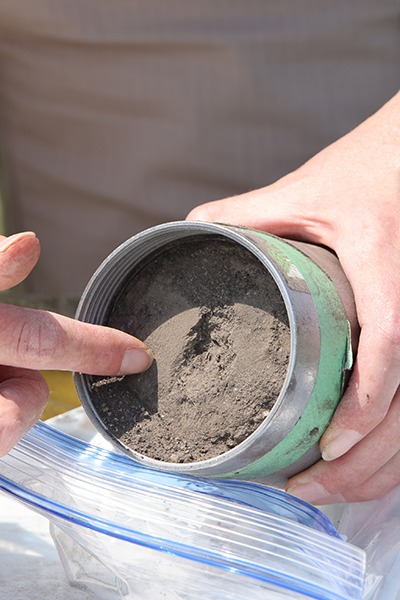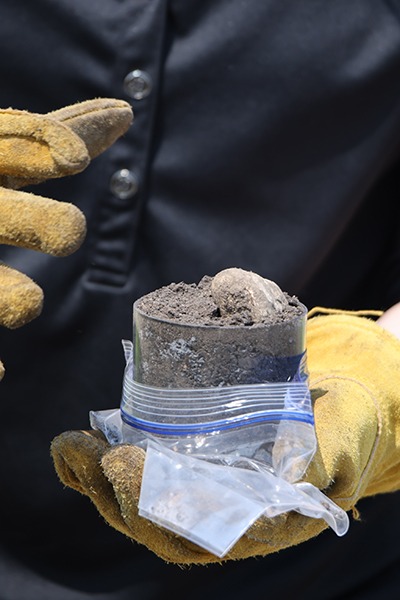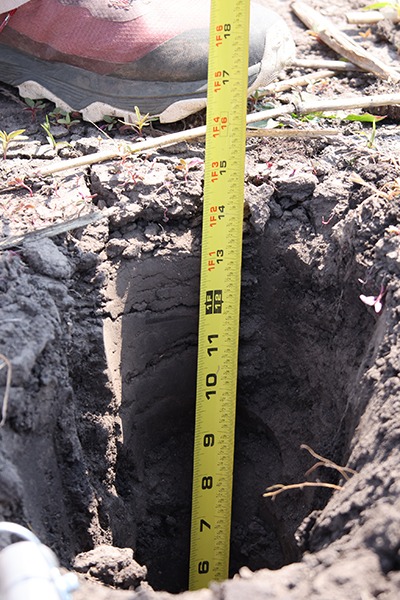What’s the Difference Between Total Soil Carbon & Soil Organic Carbon?
This article was adapted from “Assessing Soil Health: Soil Carbon Cycling and Storage” first published on Nov 3, 2020, in Crops & Soils magazine.
The short answer: Total soil carbon includes both organic and inorganic carbon. Soil organic carbon includes the once-living matter from plants, dead leaves, roots, and soil microbes, while inorganic carbon is mineral-based and much less responsive to management.

Soil cores are sampled from a corn field for nitrogen analysis. Photo by Jaclyn Fiola.
Break it down: There are four important terms to keep in mind when we talk about soil carbon. These terms are used in measurements, laboratory tests, and metrics for carbon markets and monitoring soil health.
- Soil organic matter (SOM) includes all the carbon-based compounds that were once in living organisms.
- In the lab, soil organic matter is determined by taking a soil sample and heating it to combust organic matter, weighing the sample before and after firing.
- This “loss-on-ignition” test isn’t completely accurate in determining just the amount of carbon in the soil—it includes other non-carbon mineral components that can be dried out, like water in gypsum.
- Compared to soil organic carbon, soil organic matter is found in roughly a two-to-one ratio in soil samples. This conversion is important—many labs relate SOC to SOM by using the formula SOC x 1.72 = SOM. But there are better metrics that more accurately assess soil carbon.
- Total soil carbon is measured through dry combustion of a soil sample.
- Dry combustion is a more accurate test than loss-on-ignition because it tracks the evolution of CO2 which is the amount of carbon dioxide gas produced as a carbon compound degrades.
- Soil inorganic carbon is typically found in the form of carbonates—minerals like calcite (CaCO3) or dolomite (MgCO3).
- A soil pH of 7.2 is the telltale sign for high levels of soil inorganic carbon. When dilute hydrochloric acid is dropped onto soil, it will bubble and fizz as it reacts with these carbon sources.
- In the lab, analysts will measure the amount of carbon dioxide given off when these minerals within a soil sample are exposed to acid.
- Soil organic carbon (SOC) is the portion of total soil carbon that comes from formerly living sources and is the most accessible source of food for soil microbes.
- This number is determined by removing the soil inorganic carbon from the total soil carbon and is typically reported as a percentage of the complete soil sample.
So what’s the fuss about soil organic carbon?
- Improving soil organic carbon levels can also lead to lots of improvements in soil function, crop resilience and yields, water filtration and movement, and aggregate stability.
- Compared to inorganic carbon, soil organic carbon is responsive to land management and much more dynamic.
In short, accurately measuring soil organic carbon is a key component of measuring soil health. Experts at the Soil Health Institute and National Resource Conservation Service recommend using SOC from dry combustion to track your management impact on soil health.
Photo by John A. Kelley and courtesy of USDA-NRCS.








